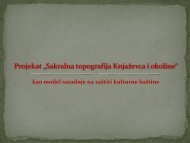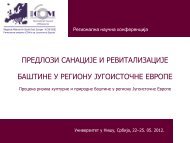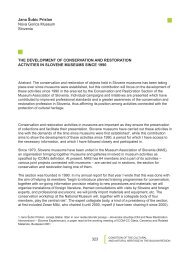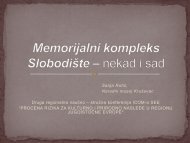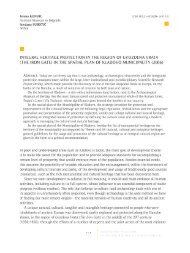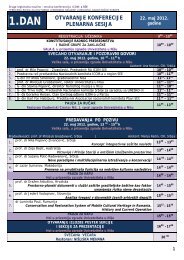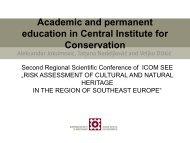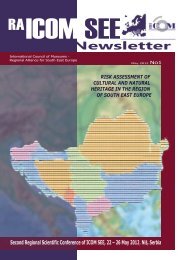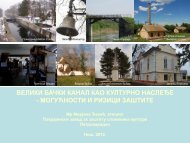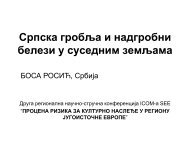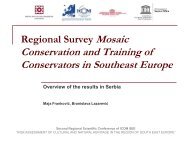67 Anica Gorgievska Institute and Museum – Bitola ... - ICOM-SEE
67 Anica Gorgievska Institute and Museum – Bitola ... - ICOM-SEE
67 Anica Gorgievska Institute and Museum – Bitola ... - ICOM-SEE
You also want an ePaper? Increase the reach of your titles
YUMPU automatically turns print PDFs into web optimized ePapers that Google loves.
Lets go back to our problem <strong>–</strong> since the very beginning we were very much aware of the complex<br />
task that is ahead of us.<br />
This is how the road map for prevention of these previous floor mosaics took place:<br />
With modest amount of funds allocated by the Ministry of Culture of the Republic of Macedonia in<br />
1998 <strong>and</strong> 1999 there was sanctioning of the floor mosaics in the Nartex (picture 4) <strong>–</strong> which is the<br />
masterpiece of the early Christian arts, the baptisterium <strong>and</strong> the catechumenium of the Great<br />
Basilica (total surface or around 150 m2).<br />
In the year of 2000 there were funds received by PHARE Program for development of culture in<br />
Macedonia which finalized the works needed for the whole complex of the Great Basilica (No.<br />
9,10,11, 5,6,7 on the Plan) in the total surface of 448 m2: the northern section <strong>–</strong> 150m, the<br />
northern annex (chapel with atrium <strong>–</strong> 48m), Naos 184m, south annex <strong>–</strong> 31m, south section <strong>–</strong> 35 m.<br />
<strong>and</strong> re-conservation was performed on the mortar underlay in the Naos (Eastern half <strong>–</strong> 370 m) .<br />
In the year of 2001 the works were focused on the mosaic surface of the Episcopal Residency with<br />
total surface of around 250m2.<br />
Since the largest conservation interventions were carried out during the PHARE Project for<br />
development of culture in Macedonia in the section below we will reflect more about the realization<br />
of this Project i.e. will provide an overview on how the works on the mosaic surfaces in the Great<br />
Basilica progressed 7 .<br />
Initial organizational procedures<br />
The organizational procedures were implemented in three phases;<br />
1. Raising of the old s<strong>and</strong><br />
The thing to do first was to remove the old <strong>and</strong> obsolete s<strong>and</strong> over these mosaics. We do not need<br />
to mention the fact that this s<strong>and</strong> dates from 20, 30, 40 years ago <strong>and</strong> our greatest enemy <strong>–</strong> time <strong>–</strong><br />
did what it could do. There were plans everywhere (picture 5). There were weeds <strong>and</strong> roots <strong>and</strong><br />
even bigger roots on occasions that were necessary to be treated biologically in order to avoid<br />
accidental ripping of the mosaic stones together with the weeds i.e. roots. On the other side, the<br />
roots release acids that damage the mortar.<br />
1. Sanitation of the mosaics<br />
After the mosaic surface was uncovered the next thing to be done was to observe the damages.<br />
Unfortunately, our ascertainment was that the damages are far greater than expected.<br />
We faced double damage: ordinary damage (coming off of the mosaics from their own surface)<br />
<strong>and</strong> damages of the mosaics from the conservated surface (picture 6).<br />
The most sensitive parts were first subject to conservation interventions <strong>–</strong> the mosaic in the<br />
Northern Annex (the Chapel with Atrium of the Great Basilica). This is mosaic made with<br />
significantly small stones that are very gentle.<br />
7<br />
<strong>Anica</strong> Gjorgjievska <strong>–</strong> advisor for conservation, Head of the Project, Momchilo Petrovski <strong>–</strong> University professors -<br />
consultant, Engin Nasuh <strong>–</strong> professional collaborator, Efto Dimovski <strong>–</strong> expert for mosaics conservation, Gjorgi Dimovski <strong>–</strong><br />
assistant for conservation, Nikola Dimovski <strong>–</strong> technical documentation<br />
70 [<br />
CONDITION OF THE CULTURAL<br />
AND NATURAL HERITAGE IN THE BALKAN REGION



